2021 MERCEDES-BENZ GLS SUV trailer
[x] Cancel search: trailerPage 52 of 510
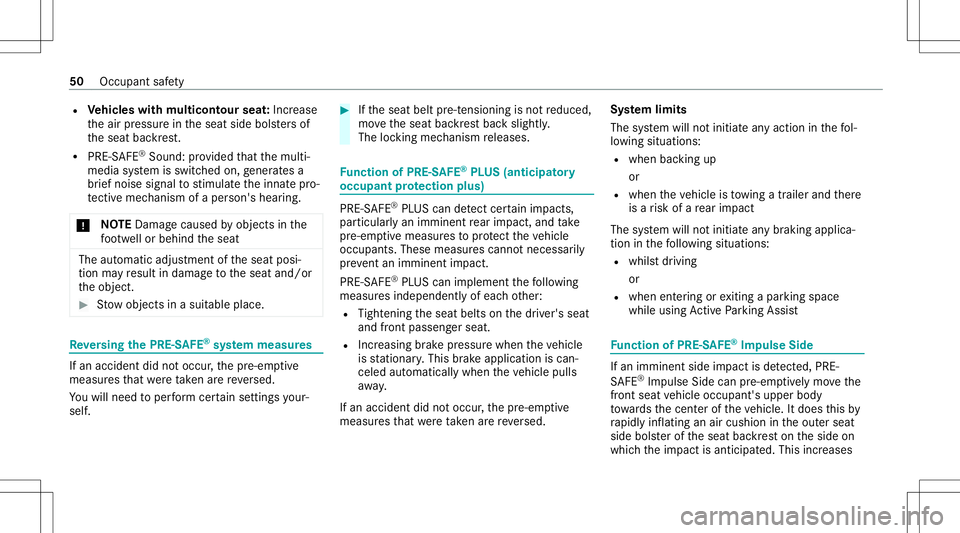
R
Vehicl eswith multico ntour seat :Incr ease
th eair pressur ein theseat sidebolsters of
th eseat backres t.
R PRE-S AFE®
Sound: prov ided that themulti‐
media system isswitc hedon,gener ates a
br iefnoi sesigna lto stimulat eth einnat epr o‐
te ctiv emec hanism ofaper son's hearing.
* NO
TEDama gecau sed byobject sin the
fo ot we llor behin dth eseat The
automatic adjustmentof theseat posi‐
tion mayre sult indamag eto theseat and/or
th eobjec t. #
Stow object sin asuit able place. Re
versing thePRE- SAFE®
sy stem mea sures If
an acc iden tdid notocc ur,th epr e-em ptive
measur esthat we retak en arere ve rsed.
Yo uwill need toper form certainse ttings your‐
self . #
Ifth eseat beltpre-t ension ingisno tre duced,
mo vetheseat backres tbac kslightl y.
The locking mechanism releases. Fu
nction ofPRE-S AFE®
PL US (anticipat ory
occupant protection plus) PRE-
SAFE®
PL US can detect cer tain im pact s,
par ticular lyan imm inentrear impact ,and take
pr e-em ptive measur estoprotect theve hicle
occupants. Thesemeasur escanno tnecessar ily
pr eve ntan imm inentimpact.
PR E-S AFE ®
PL US can implem entthefo llo wing
measur esindepe ndently of eac hot her :
R Tight ening theseat belts onthedr iver's seat
and front passeng erseat.
R Increasin gbr ak epr essur ewhen theve hicle
is statio nary.This brak eapplication iscan‐
celed automaticall ywhen theve hicle pulls
aw ay.
If an accident didnotoccur ,th epr e-em ptive
measur esthat we retake nar ere ve rsed. Sy
stem limit s
The system will notinitiat ean yaction inthefo l‐
lo wing situat ions:
R when backingup
or
R when theve hicle istowing atrailer andther e
is arisk ofare ar impact
The system will notinitiat ean ybr aking applica‐
tion inthefo llo wing situat ions:
R whils tdr ivin g
or
R when entering orexitin gapar kingspace
while using ActivePa rking Assist Fu
nction ofPRE-S AFE®
Im pulse Side If
an imminen tside impact isde tected, PRE-
SA FE®
Im pulse Side canpre-emp tively movethe
fr ont seatve hicle occupant's upperbody
to wa rdsth ecent eroftheve hicle. Itdoes this by
ra pidly inflating anair cushion intheout erseat
side bolsterof theseat backres ton theside on
whic hth eim pact isantic ipated.This increases 50
Occupant safety
Page 204 of 510

4
Ultrasonic sensors
5 Rear vie wcam era
% Depen dingon theve hicle's equipment, the
ra dar sensor sar eint egratedbehind the
bum persand/or behindthera diat orgrill.
Some driving anddriving safetysy stems use
camer asaswellas radar orultr asonic sensors
to monit orthear ea infront of,behind ornext to
th eve hicle.
Ke ep thear eas around thesensor sand camer as
fr ee ofdir t,ice orslush (/page332). Thecam‐
er as and sensor smus tno tbe covered, forex am‐
ple bybicy clerack s, overhanging loads,sticke rs,
fo ilor foils toprotect agains tst one chipping .
Ad dition allicense platebr ac kets can impai rth e
function oftheultr asonic sensors,in par ticular .
In theeve ntofdama georase vere impact inthe
ar ea ofthesensor s,ha ve thefunc tion ofthe
sensor sch eckedat aqu alif ied spec ialistwo rk‐
shop. Have damag eor stone chipping inthear ea
of thecamer asrepair edataqu alif ied spec ialist wo
rkshop. Ifth esensor sor camer asaredam‐
ag ed, some driving systems anddriving safety
sy stems mayno long erfunc tion proper ly. Ov
ervie wof driving systems anddriving
saf etysy stems R
ABS(Ant i-lockBra king System)
(/ page203)
R Off-road ABS (/page203)
R BAS(Bra keAssis tSyst em) (/page203)
R ESP®
(Elect ronic Stability Program)
(/ page203)
R ESP ®
Cr osswind Assist(/ page206)
R ESP ®
trailer stabiliz ation(/ page20 6)
R EBD(Elect ronic Brakeforc eDis tribution)
(/ page20 7)
R STEER CONTR OL(/ page 207)
R ActiveBr ak eAssi st(/ pag e20 7)1
R Cruise control (/ page21 2) R
DSR (Dow nhillSpe edRegulatio n)
(/ page 214)
R ActiveDis tance AssistDIS TRONI C
(/ page 216)1
R ActiveSpe edLimi tAssi st(/ pag e220) 2
R Route-based speedadap tatio n
(/ page 221)2
R ActiveSt eer ing Assis t(/ page222) 2
R ActiveLa ne Chang eAssi st(/ pag e22 4)2
R ActiveEmerg encyStop Assis t(/ page226) 2
R ActiveTr af fic Ja m Assi st(/ pag e22 7)2
R Hill StartAs sis t(/ page22 7)
R HOL Dfun ction (/ page22 8)
R AIRMA TIC(/ page22 9)
R E-AC TIVE BODY CONTR OL(/ page236)
R Parking AssistPA RK TRONI C(/ page24 4)
R Rear vie wcam era(/ page24 9)
R Surround viewcam era(/ page25 2)
1 This function includes subfunctions whic har eon lyavailable incon junction withth eDr iving Assistance Packag e.
2 This function iscoun try- dependen tand onlyav ailable incon junction withth eDr iving Assistance Packag e. 202
Drivin gand parking
Page 208 of 510
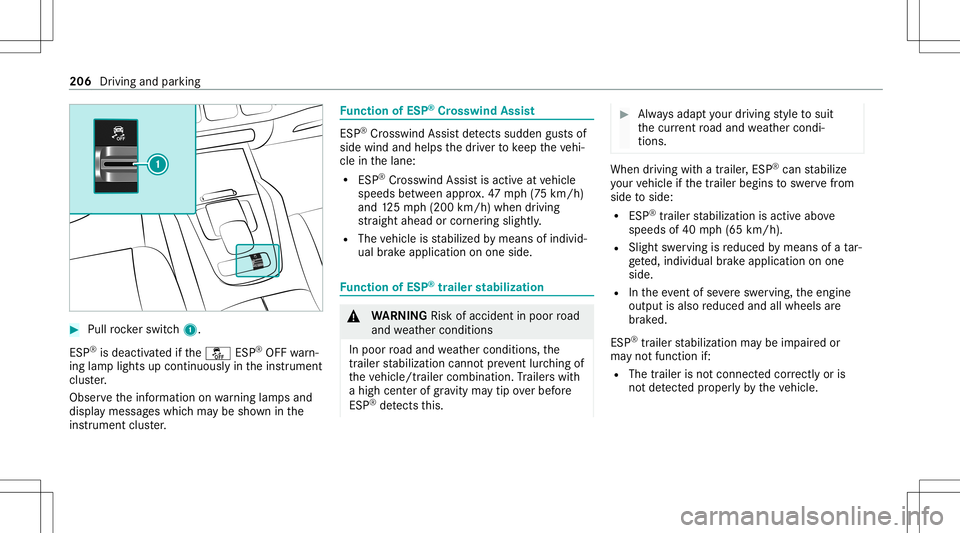
#
Pull rock er switc h1.
ES P®
is deactiv ated ifth e00BB ESP®
OFF warn‐
ing lam plight sup con tinuousl yin theins trument
clus ter.
Obser vetheinf ormation onwarning lam psand
displa ymess ages whic hma ybe sho wninthe
ins trumen tclus ter. Fu
nction ofESP ®
Cr osswind Assist ES
P®
Cr osswind Assistde tects sudde ngu stsof
side wind andhelps thedr iver tokeep theve hi‐
cle inthelane:
R ESP®
Cr osswind Assistis activ eat vehicle
speeds between appr ox.47 mp h(7 5 km/h)
and 125mp h(200 km/h) whendriving
st ra ight ahead orcor ner ing slight ly.
R The vehicle isstabiliz edbymeans ofindivi d‐
ua lbr ak eapp lication onone side. Fu
nction ofESP ®
trailer stabil izatio n &
WARNIN GRisk ofacci dent inpoo rro ad
and weather condition s
In poor road and weather condition s,the
tr ai le rst abiliz ationcan notpr ev ent lurching of
th eve hicle/tr ailercombination. Trailer swit h
a high centerof grav ity ma ytip ove rbef ore
ESP ®
de tects this. #
Alw aysadap tyo ur drivin gst yle to suit
th ecur rent road and weather condi‐
tio ns. When
drivin gwit hatrailer ,ES P®
can stabiliz e
yo ur vehicle ifth etrailer begins tosw erve from
side toside:
R ESP ®
traile rst abiliz ationis act ive abo ve
speeds of40 mph(65 km/h).
R Slight swerving isreduced bymeans ofata r‐
ge ted, individual brak eapplication onone
side.
R Intheeve ntofsevere sw erving, theengine
output isalso reduced andallwheels are
br ak ed.
ES P®
tra iler stabiliz ationma ybe impair edor
ma yno tfun ction if:
R The trailer isno tcon nectedcor rectl yor is
no tde tected prope rly by theve hicle. 206
Driving andparking
Page 223 of 510
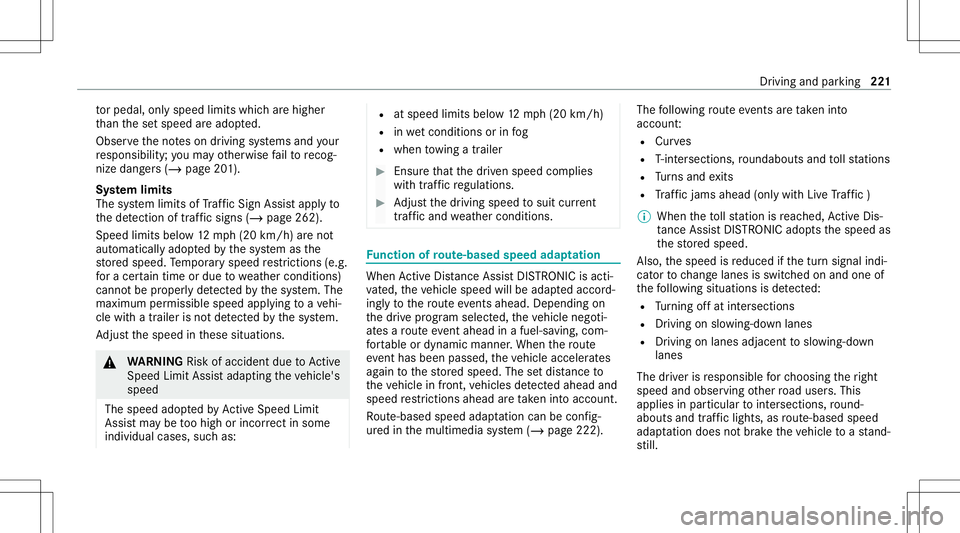
to
rpeda l,onl yspee dlimi tswhi charehigh er
th an these tspeed areadop ted.
Obser vetheno teson driving systems andyour
re sponsibili ty;yo uma yot her wise failto recog‐
nize dangers(/ page 201).
Sy stem limit s
The system limits ofTraf fic Sign Assistappl yto
th ede tection oftraf fic sig ns (/ page 262) .
Speed limitsbel ow 12mp h(20 km/h) areno t
aut omaticall yadop tedby thesy stem asthe
st or ed speed. Temp oraryspeed restrictions (e.g.
fo ra cer tain tim eor due towe ather condition s)
can notbe proper lyde tected bythesy stem. The
maximum permissible speedapplying toave hi‐
cle withatrailer isno tde tected bythesy stem.
Ad jus tth espeed inthese situation s. &
WARNIN GRisk ofacci dent dueto Active
Spe edLimi tAssi stadap tingth eve hicle's
speed
The speed adoptedby ActiveSpe edLimi t
Assi stma ybe toohigh orincor rect insome
indi vidualcase s,su ch as: R
atspee dlimit sbelo w12 mp h(20 km/h)
R inwe tcond itions orinfog
R when towing atrailer #
Ensur eth at thedr iven speed complies
wit htraf fic re gulations. #
Adjus tth edr iving speed tosuit current
tr af fic and weather condition s. Fu
nction ofrout e-base dspee dadap tation When
ActiveDis tance AssistDIS TRONI Cis acti ‐
va ted, theve hicle speed willbeadap tedaccor d‐
ing lyto thero uteev ent sahead. Dependingon
th edr ive pr og ram sele cted, theve hicle negoti‐
at es aro uteeve ntaheadin afue l-saving, com ‐
fo rtable ordynam icman ner.When thero ute
eve nthasbe en passe d,theve hicle acceler ates
ag ain tothestor ed speed. Thesetdis tance to
th eve hicle infront, vehicles detected aheadand
spe edrestrictions aheadar eta ke nint oacco unt.
Ro ute-based speedadap tatio ncan beconf ig‐
ur ed inthemultimedia system (/ page222). The
follo wing routeeve nts areta ke nint o
acco unt:
R Curves
R T-int ersect ions,ro und about sand tollst atio ns
R Turnsand exits
R Traf fic jams ahead(only with Liv eTraf fic )
% Whe nth eto llst atio nis reac hed, ActiveDis ‐
ta nce AssistDIS TRONI Cad op tsthespeed as
th estor ed speed.
Also, thespeed isreduced ifth etur nsignal indi‐
cat ortochang elane sis swit ched on and one of
th efo llo wing situat ionsisde tected:
R Turning offat intersect ions
R Drivin gon slowing- down lanes
R Drivin gon lanes adjacenttoslo wing-do wn
lanes
The driver isresponsible forch oosing theright
speed andobser vingother road user s.This
applies inpar ticular tointersect ions,ro und ‐
about sand traffic lights, asroute-based speed
adap tatio ndo es notbr ak eth eve hicle toast and‐
st ill. Dr
ivin gand parking 22
1
Page 224 of 510
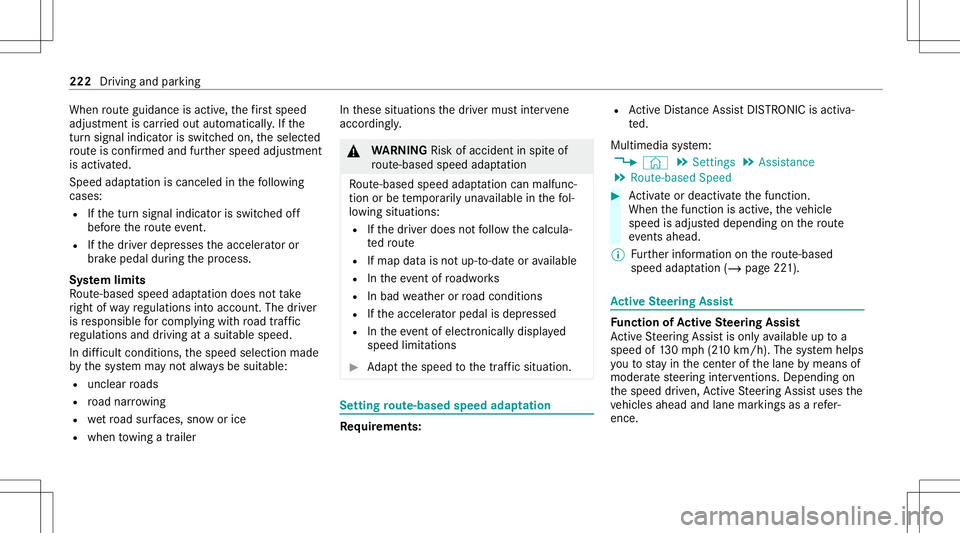
When
routeguidan ceisact ive, thefirs tsp ee d
ad jus tment iscar ried out automaticall y.Ifth e
tur nsigna lind icatoris switc hedon,theselect ed
ro uteis co nfirmed andfurther speed adjustment
is activ ated.
Speed adaptatio nis canc eled inthefo llo wing
cases :
R Ifth etur nsignal indicat orisswitc hedoff
bef oreth ero uteev ent .
R Ifth edr iver depr esses theaccelera toror
br ak epeda ldur ing thepr ocess.
Sy stem limit s
Ro ute-based speedadap tatio ndo es nottak e
ri ght ofwa yre gulations intoaccount .The driver
is responsible forcom plying withro ad traf fic
re gulations anddriving atasuit able speed.
In dif ficul tcondi tions,th espeed selectionmade
by thesy stem mayno talw aysbe suit able:
R unclear roads
R road nar rowing
R wetro ad sur faces, snowor ice
R whe nto wing atrailer In
these situation sth edr iver mus tint erve ne
acco rding ly. &
WARNIN GRisk ofacci dent inspi teof
ro ute-based speedadap tatio n
Ro ute-based speedadap tatio ncan malfunc‐
tio nor be temp orarily una vailable inthefo l‐
lo wing situat ions:
R Ifth edr iver does notfo llo wthecalcula‐
te dro ute
R Ifmap datais no tup-t o-dat eor available
R Intheev ent ofroadw orks
R Inbad weather orroad con dition s
R Ifth eacceler ator pedal isdepr essed
R Intheeve ntofelectr onicallydispla yed
speed limitations #
Adaptth espeed tothetraf fic situ ation. Se
tting rout e-base dspee dadap tation Re
quirement s: R
ActiveDis tance AssistDIS TRONI Cis acti va‐
te d.
Multimedia system:
4 © 5
Set ting s5
Assist ance
5 Route-based Speed #
Activateor deacti vate thefunc tion.
When thefunc tion isactiv e,theve hicle
speed isadjus teddependin gon thero ute
eve nts ahead.
% Further information onthero ute-based
spee dadap tatio n(/ page 221). Ac
tiv eSte ering Assis t Fu
nction ofActiv eSte ering Assis t
Ac tiveSt eer ing Assis tis onl yav ailable uptoa
speed of130mp h(210 km/h) .The system helps
yo uto stay inthecent erofthelane bymeans of
moder atesteer ing interve ntio ns.Dep endingon
th espeed driven, ActiveSt eer ing Assis tuses the
ve hicles ahead andlane markings asare fer‐
ence. 222
Driving andparking
Page 226 of 510
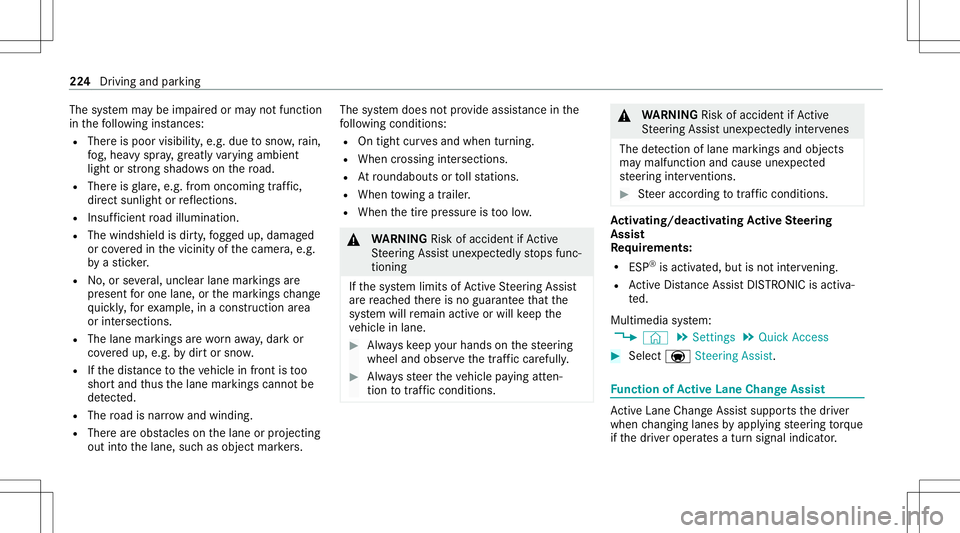
The
system maybe impair edorma yno tfunc tion
in thefo llo wing instances:
R The reispoor visibilit y,e.g. due tosno w,rain,
fo g, hea vyspr ay,gr eatl yva rying ambien t
light orstro ng sha dows onthero ad.
R Ther eis glar e, e.g .fr om oncom ingtraf fic,
di re ct sunli ght orreflect ions.
R Insuf ficie ntroad illumin ation.
R The wind shieldisdir ty,fo gg ed up, damag ed
or coveredin thevicinit yof thecamer a,e.g.
by ast icke r.
R No,or several,unc lear lane markingsare
pr esen tfo rone lane, orthemar king sch ang e
qu ickl y, forex am ple, inacon stru ction area
or intersecti ons.
R The lane mar kings arewo rnaw ay,dar kor
co veredup, e.g. bydirtor sno w.
R Ifth edis tance totheve hicle infront istoo
shor tand thus thelane marking scann otbe
de tected.
R The road isnar row and wind ing.
R Ther ear eobs tacle son thelane orprojec ting
out intoth elane, suchas objec tmar kers. The
system does notpr ov ide assis tance inthe
fo llo wing condition s:
R Ontigh tcur vesand when turning.
R When crossing intersections.
R Atround about sor tollst atio ns.
R When towing atrailer .
R When thetir epr essur eis toolow. &
WARNIN GRisk ofacci dent ifAc tive
St eer ing Assis tune xpect edlyst ops func‐
tionin g
If th esy stem limits ofActiveSt eer ing Assis t
ar ere ac hed ther eis no guar anteethat the
sy stem will remain activeor wil lke ep the
ve hicle inlane. #
Alw ayske ep your han dson thesteer ing
wheel andobser vethetra ffic car efull y. #
Alw aysst eer theve hicle paying atten‐
tion totraf fic condi tions. &
WARNIN GRisk ofacci dent ifAc tive
St eer ing Assis tune xpect edlyinterve nes
The detection oflane mar kings andobje cts
ma ymal functi onand causeune xpect ed
st eer ing interve ntio ns. #
Steer accor dingtotraf fic condi tions. Ac
tiv atin g/deac tivatin gAc tiv eSte ering
Assis t
Re quirement s:
R ESP®
is act ivat ed, but isno tint erve ning .
R ActiveDis tance AssistDIS TRONI Cis acti va‐
te d.
Multimedia system:
4 © 5
Set ting s5
Quick Access #
Select 004FSteering Assist. Fu
nction ofActiv eLan eCha ngeAs sist Ac
tiveLa ne Chang eAssi stsuppor tsthedr iver
when chang inglane sby appl ying steer ing torq ue
if th edr iver oper ates atur nsignal indicat or. 22
4
Driving andparking
Page 233 of 510
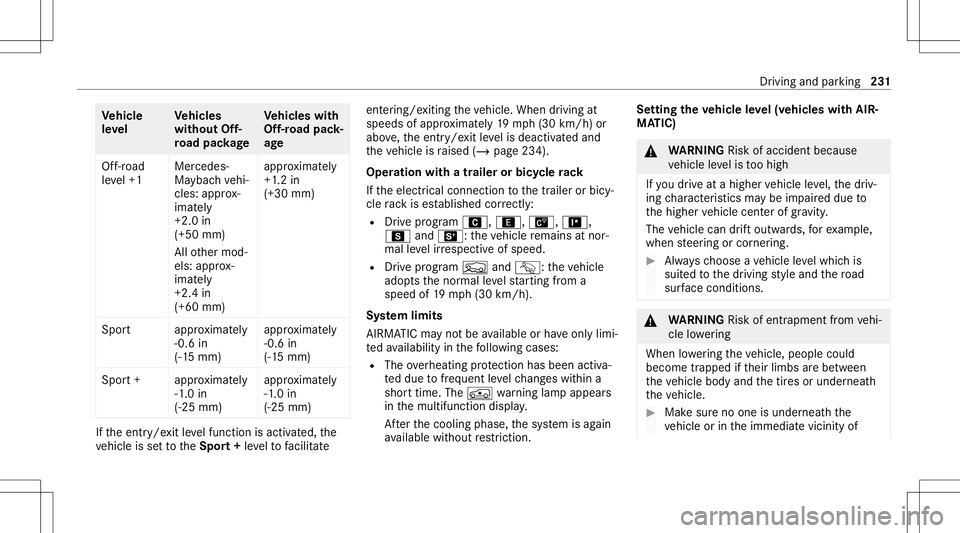
Ve
hicl e
le ve l Ve
hicl es
without Off-
ro ad pac kage Ve
hicl eswith
Of f-road pack‐
ag e
Of f-road
le ve l+1 Mer
cedes -
Ma ybac hve hi‐
cles: approx‐
imat ely
+2. 0in
(+50 mm)
All other mod‐
els: appr ox‐
imat ely
+2. 4in
(+60 mm) appr
oximat ely
+1 .2 in
(+30 mm)
Spor ta pproximat ely
-0 .6 in
(-1 5mm) appr
oximat ely
-0 .6 in
(-1 5mm)
Spor t+a pproximat ely
-1 .0 in
(-2 5mm) appr
oximat ely
-1 .0 in
(-2 5mm) If
th eent ry/e xit leve lfunc tion isact ivat ed, the
ve hicle issetto theSpor t+ leve lto facil itat e ent
ering/e xiting theve hicle. When driving at
speeds ofappr oximat ely19 mp h(3 0km/h) or
abo ve,th eent ry/e xit leve lis deact ivat ed and
th eve hicle israised (/page234).
Oper ation withatrailer orbicy clerack
If th eelectr icalconnect iontothetra iler orbicy‐
cle rack ises tablished correctl y:
R Drive pr ogr am A, ;,£,=,
C andB: theve hicle remains atnor‐
mal leve lir re spectiv eof speed.
R Drive pr ogr am F andG: theve hicle
adop tsthenor mal leve lst ar tin gfrom a
spee dof 19 mp h(30 km/h).
Sy stem limit s
AI RMA TICmayno tbe available orhave onl ylimi‐
te dav ailabilit yin thefo llo wing cases :
R The overheating protect ion has been activa‐
te ddue tofreq uent leve lch ang eswit hin a
shor ttim e.The 00C4 warning lam pappear s
in themultifunc tiondispla y.
Af terth ecooling phase,thesy stem isag ain
av ailable without restriction. Se
tting thevehicl eleve l(v ehicles withAIR‐
MA TIC) &
WARNIN GRisk ofacci dent because
ve hicle leve lis toohigh
If yo udr ive at ahigh ervehicle leve l,th edr iv‐
ing charact eristic sma ybe impair eddue to
th ehigher vehicle centerofgrav ity .
The vehicle candrift outw ards, forex am ple,
when steer ing orcor ner ing. #
Alw aysch oose ave hicle leve lwhic his
suit edtothedr iving style and thero ad
sur face condi tions. &
WARNIN GRisk ofentr apment from vehi‐
cle lowe ring
Whe nlowe ring theve hicle, people could
become trapped ifth eir limbs arebe tween
th eve hicle body andthetir es orunder neath
th eve hicle. #
Mak esur eno one isunder neathth e
ve hicle orintheimmediat evicin ityof Dr
iving andparking 23
1
Page 235 of 510
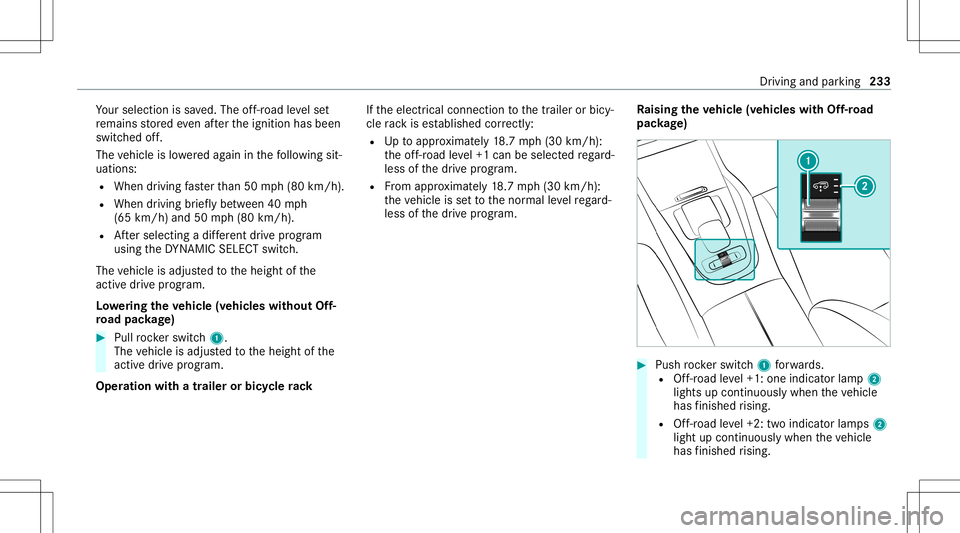
Yo
ur sele ction issave d. The off-r oad leve lse t
re mains stor ed eve naf te rth eignition hasbeen
switc hedoff.
The vehicle islowe redag ain inthefo llo wing sit‐
uation s:
R When drivin gfa ster than 50 mph(80 km/h).
R When driving brief lybe tween 40mph
(65 km/ h)and 50mph(80 km/h).
R Aftersele cting adif fere nt drive pr ogr am
us ing theDY NA MIC SELE CTswitc h.
The vehicle isadjus tedto theheight ofthe
act ive dr ive pr og ram.
Lo we ring theve hicl e(v ehic leswithout Off-
ro ad pac kage) #
Pull rock er switc h1.
The vehicle isadjus tedto theheight ofthe
act ive dr ive pr ogram.
Oper ation withatrailer orbicy clerack If
th eelectr icalconnect iontothetra iler orbicy‐
cle rack ises tablished correctly:
R Uptoappr oximat ely18 .7 mp h(3 0km/h) :
th eof f-r oad leve l+1 can beselec tedre ga rd‐
less ofthedr ive pr og ram.
R From appr oximat ely18 .7 mp h(3 0km/h) :
th eve hicle issetto thenor mal leve lre ga rd‐
less ofthedr ive pr og ram. Ra
ising theve hicl e(v ehic leswith Off-road
pac kage) #
Push rock er switc h1 forw ards.
R Off-ro ad leve l+1: one indic ator lam p2
light sup con tinuousl ywhen theve hicle
has finis hed rising.
R Off-road leve l+2: twoindic ator lam ps2
light upcon tinuousl ywhen theve hicle
has finis hed rising. Dr
iving andparking 233